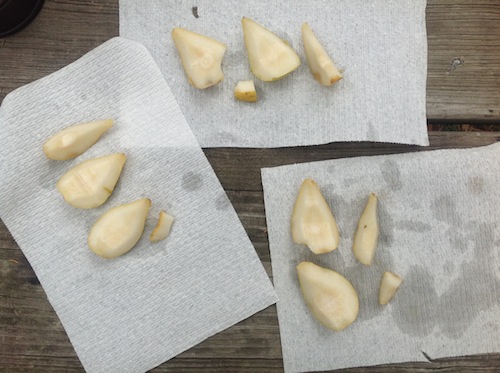I took the kids camping this weekend. Jay Cooke State Park is lovely. I recommend a visit if you have never been.
We had the following conversation at the campsite on Saturday evening.
Me: Griff, we have two pears and three people. What should we do about that?
Griffin (9 years old): Cut them in 3 pieces.
Me: How much does each person get in that case?
G: One and a third, I think…No…I don’t know.
His attention returns to the campfire, which is of course endlessly fascinating. A minute later, I try again.
Me: Tabitha! Two pears, three people. I’m going to cut them in half. That’s four pieces. You each get one. I get two. Fair?
Tabitha (6 years old): NO!
She passes a few moments pondering while I take the pears over to the picnic table.
T: You should cut them in four pieces. Give each of 1, then put the other away for tomorrow.
I originally interpret this to mean cut each of the pears in four pieces. Afterwards I am not so sure what she meant. In any case, I did what I thought she suggested.
Me: Tabitha, I did most of what you said. We each got 2 of those pieces. There are 2 leftover. I’m going to cut those in half. We each get 1 of those littler pieces.
Now what should we do with this last little piece?
She thinks
T: Cut it!
Me: In how many pieces?
T: Three!
I do so and we admire our handiwork.
So What Do We Learn?
The first fraction most children encounter in a serious way is one-half, and this is nearly always through fair-sharing.
Two kids, one pear (or cookie, or cupcake, or doll…) this is where children begin to think about fractions. They do not think about the notation of fractions, but they think about the important idea of fractions: A thing can be cut into equal pieces, and there is a name for these pieces.
Sharing multiple things in a way that involves cutting—as 2 pears among 3 people—is much more challenging than sharing one thing.
Nevertheless, this experience of halving is so fundamental that children often want to solve everything by halving. As long as we are willing to cut halves in half, this can be a powerful way of working things out.
Griffin’s idea to cut each pear in three pieces, then, is relatively sophisticated. That he could not name the resulting share should be no surprise in a campground conversation where the cutting is all imaginary and unwritten.
That this did not immediately occur to the younger child is no surprise. Likewise the idea to save the extra piece for another time is typical of young children’s thinking about fair sharing.
Cutting that last piece into three was a triumphant idea for her.
See Extending Children’s Mathematics for lovely, detailed writing about these ideas.
Starting the Conversation
Buy two pears. Get yourself two children of different ages. Ask them how to share the pairs fairly. Do what they tell you to do and ask follow up questions such as Is this fair? Do we all have the same amount? How do we all have? and What should we do with these leftover pieces?


